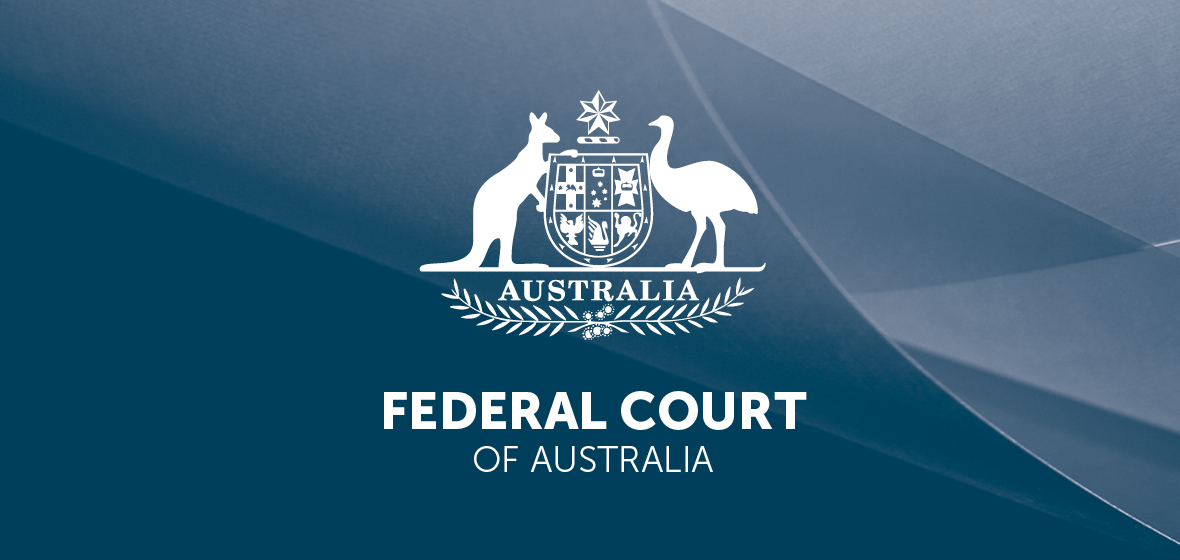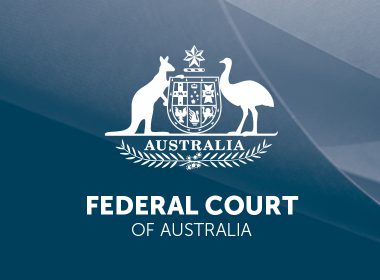Key decisions
- Redbubble Ltd v Hells Angels Motorcycle Corporation (Australia) Pty Ltd [2024] FCAFC 15 (David Townsend)
- Archbishop Makarios Griniezakis v Morelas [2024] FCA 100 (Parisa Hart)
CONTRACTS
Settlement agreement – construction – broad words used – settlement agreement to be read according to what was in contemplation of parties
Redbubble Ltd v Hells Angels Motorcycle Corporation (Australia) Pty Ltd [2024] FCAFC 15 (Perram, Nicholas, Burley, Rofe and Downes JJ)
In this case a five-judge bench of the Full Court of the Federal Court of Australia considered questions relating to the proper quantum of nominal and additional damages for breaches by Redbubble Ltd (‘Redbubble’) of trade marks in certain classes held by Hells Angels Motorcycle Corporation (Australia) Pty Ltd (‘Hells Angels Australia’) and injunctive remedies. In the course of doing so, the Court interpreted a settlement agreement which bound the parties, the terms of which were, in their literal interpretation, broad enough to release Redbubble’s liability for certain of the breaches. This case note addresses the Court’s exposition of the principles applicable to the construction of a settlement agreement; the trade mark infringement and damages issues are only touched on incidentally.
Background
Redbubble operated a website whereby ‘creators’ could upload graphic designs to the website and then consumers could select one of those designs, select an item of merchandise (such as a cap, T-shirt or mug), view a simulated version of the merchandise as it would appear with the design printed on it, and then order the item with the design printed on it. (The items with designs printed on them were not held in stock, but were produced to order by suppliers who were connected through the Redbubble website.) There was potential for trade mark infringement where ‘creators’ uploaded images in breach of another person’s registered trade mark. Although Redbubble maintained content moderation over the uploading of designs by ‘creators’, with over 90,000 images per day uploaded to Redbubble’s website, ‘these systems were neither perfect nor instantaneous. The imperfections in these systems have brought Redbubble into contact with the Hells Angels’ (at [5]-[6]). Hells Angels Motorcycle Corporation (‘Hells Angels USA’), an entity incorporated in California, was the registered proprietor of five Australian trade marks. The trade marks were for the words ‘Hells Angels’ [sic] and/or various images of a skull wearing a winged helmet; they were registered for various classes, relevantly Class 16 (printed matter) and Class 25 (apparel). Hells Angels USA had entered into an exclusive licence agreement with Hells Angels Australia for the use of the five registered trade marks. Various third party ‘creators’, without authorisation of Hells Angels Australia (or, for that matter, Hells Angels USA) had uploaded designs to the Redbubble website containing the words ‘Hells Angels’ and/or various images of a skull wearing a winged helmet. Hells Angels Australia brought suit against Redbubble for infringement of the five trade marks (and various copyright infringements and contraventions of the Australian Consumer Law which are not relevant to the appeal) (‘Australian Dispute’).
In the USA, there was a separate intellectual property dispute (‘US Dispute’) between Hells Angels USA and TP Apparel LLC (‘TP Apparel’), by which Hells Angels USA claimed that TP Apparel infringed its intellectual property by the operation of a certain online marketplace. Redbubble had acquired TP Apparel and thereby become its corporate parent.
On 24 May 2021, in the context of settling the US Dispute, a settlement agreement had been entered into between TP Apparel ‘and its corporate parent and affiliates’ and Hells Angels USA, whereby Hells Angels USA gave releases on its own behalf and on behalf of its licensees. Thus, the settlement agreement was competent to bring about a release of the rights of Hells Angels Australia (as licensee of Hells Angels USA) against Redbubble (as corporate parent of TP Apparel) in the Australian Dispute, and Hells Angels Australia accepted as much. What was in dispute was whether the settlement agreement, on its proper construction, did actually release Hells Angels Australia’s rights in the Australian Dispute. The settlement agreement released (relevantly) Redbubble from all actions that (relevantly) Hells Angels Australia may have had against it as at 24 May 2021 which were ‘arising from or related to the Disputes or any other matter’. ‘The Disputes’ were defined in the settlement agreement as including certain disputes disclosed in identified correspondence between the parties to the settlement agreement.
The question of the construction of the settlement agreement was heard by Jagot J (then of the Federal Court of Australia), who determined that settlement agreement did not release Hells Angels Australia’s rights against Redbubble in the Australian Dispute. Subsequently, Greenwood J delivered judgment in favour of Hells Angels Australia in the Australian Dispute. Redbubble appealed to the Full Court from both Greenwood J’s and Jagot J’s decisions, although only Jagot J’s decision is relevant to the point of the construction of the settlement agreement.
The Australian Dispute simply was not in the contemplation of the parties to the settlement agreement when the release was given.
Decision
The lead judgment was the joint judgment of Perram and Downes JJ, with whom Nicholas, Burley and Rofe JJ (in joint judgment) agreed on the issue of the construction of the settlement agreement (and generally, save for some additional points as to injunctive relief).
The terms used in the settlement agreement, on their literal or prima facie meaning, were broad enough to release Hells Angels Australia’s rights against Redbubble in the Australian dispute, as the definition of ‘the Disputes’ in the settlement agreement was inclusive, not exhaustive, and in any event the release also applied to actions ‘arising from or related to… any other matter’. However, ‘there is a prima facie presumption at common law that general words in a release are construed as being limited to the matters which were specifically in the contemplation of the parties at the time the release was given’ (at [38]). Similarly, in equity, a party could not rely on a release if it would be unconscientious to do so by reference to the ‘true purpose of the transaction as ascertained from the nature of the instrument and the surrounding circumstances including the state of knowledge of the respective parties concerning the existence, character and extent of the liability in question and the actual intention of the releasor’ (Grant v John Grant & Sons Pty Ltd [1954] HCA 23; 91 CLR 112 at 129-130). (At [38] their Honours discuss, by way of obiter dicta, the unresolved question of the admissibility of evidence of subjective intention in equity but not at law, but this was not dispositive of the issue in the present case as all the evidence was of objective intention.)
The evidence was that what was in the contemplation of the parties to the settlement agreement at the time it was made was not the Australian Dispute, but rather was only the US Dispute. All the correspondence to which the recitals in the settlement agreement referred (which formed part of the inclusive definition of ‘the Disputes’ in the settlement agreement) related to the US Dispute and did not touch on the Australian Dispute. Their Honours construed the words ‘or any other matter’ according to the same presumption as to what was in the contemplation of the parties, which was the US Dispute, not the Australian Dispute. There were other clauses of the settlement agreement which referred to issues which arose only in respect of the US Dispute, and not on the Australian Dispute. In short, the Australian Dispute simply was not in the contemplation of the parties to the settlement agreement when the release was given. The Full Court therefore upheld Jagot J’s decision that the release only operated in respect of the US Dispute and not the Australian Dispute, describing her Honour’s decision below as a ‘conclusion… as orthodox as it is self-evidently correct’ (at [42]). In response to what Perram and Downes JJ described as Redbubble’s attempt to rehearse before the Full Court the same arguments that had been made, unsuccessfully, before Jagot J, their Honours accepted that the words of the settlement agreement were literally broad enough to have operated as a release in respect of the Australian Dispute, but countered:
‘However, this is not the question. The prima facie canon of construction takes the width of the release as its point of departure. Thus, Redbubble’s submission that the release is broad is beside the point. The correct question is whether the [relevant aspect of the Australian Dispute] was in the contemplation of the parties, objectively determined, at the time the release was given’ (at [43]).
Significance
Subject to any application for special leave which may be lodged and the outcome thereof, this case provides a salutary reminder of the orthodoxy that a) the terms of a release in a settlement agreement or deed of release are to be construed objectively (at law at least, leaving aside any unresolved issues as to construction in equity) and b) the literal or prima facie meaning of the terms is the beginning, but not necessarily the end, of the construction exercise, as the terms are to be construed according to the presumption that the release is limited to what was in the contemplation of the parties at the time of the release. In practical terms, it is unwise to rely merely on broadly-worded terms of release if there are specific disputes (or aspects thereof) which the parties wish to be covered by the release: parties are best advised to state, in the terms of the settlement agreement/deed of release itself, the specific disputes it applies to – rather than risk a secondary dispute about the extent of the release of a primary dispute!
The literal or prima facie meaning of the terms is the beginning, but not necessarily the end, of the construction exercise…
PRACTICE AND PROCEDURE
Rule 2.02 Federal Court Rules 2011 (Cth) – section 48 Federal Court of Australia Act 1976 (Cth) – application for transfer of proceedings commenced in the NSW District Registry to Victoria District Registry
Archbishop Makarios Griniezakis v Morelas [2024] FCA 100 (Abraham J)
The Federal Court of Australia dismissed an application for transfer of proceedings commenced in the New South Wales District Registry to the Victoria District Registry. Despite the applicant being at a significant financial disadvantage, Abraham J found the balance of convenience favoured the applicant. Her Honour distinguished the present case from the facts of Truong Giang Corporation v Tung Mau Quach [2014] FCA 447, highlighting the location of witnesses and the causes of action are also factors to be considered.
Background
On 9 March 2022, the applicant brought a defamation claim in the New South Wales District Registry against the respondent, Mr Morelas, over four articles published on the website Greek Flash News (Greek Flash Website) between August and September 2021. The Archdiocese operates Australia-wide and its headquarters are in Sydney where the applicant resided. The respondent lived in Melbourne and, at the time of the application, was unrepresented.
The respondent made an application pursuant to rule 2.02 of the Federal Court Rules 2011 (Cth) (‘FCR’), for an order under section 48 of the Federal Court of Australia Act 1976 (Cth) (‘FCA Act’) transferring the proceeding to the Victorian District Registry.
Respondent’s submissions
The respondent claimed that the application for transfer should be granted for the following reasons (at [11]-[14]):
- He had limited resources to defend the proceeding. He was receiving the Single Aged Pension of $1,200 per fortnight, including rental assistance and carer’s support. His only asset was real estate in Greece worth approximately €20,000 to €30,000. Therefore, he was unable to fund the travel, accommodation or other costs involved in a hearing held in Sydney;
- His medical condition (rheumatoid arthritis) made travel more onerous;
- The disparity in the financial resources he had compared to the applicant. The applicant held a national position, had an office in Melbourne and would have no difficulty in sourcing accommodation for himself and his legal team in Melbourne for the duration of the hearing;
- There was no suggestion that a transfer would have an adverse effect on the applicant other than the need for his Sydney-based legal team to travel to Melbourne which should be regarded as a ‘neutral factor’: citing Truong Giang Corporation v Tung Mau Quach [2014] FCA 447 (‘Truong’) at [11]; and
- If the proceedings were transferred to the Victorian Registry, all Sydney-based witnesses could be accommodated by videoconference link.
Therefore, the transfer would result in relatively little disruption to the efficient management of the proceeding and the balance of convenience favoured having the trial in Melbourne.
Her Honour stated that the location of the witnesses who were likely to give evidence in the trial was an important consideration.
Applicant’s submissions
The applicant resisted the application, contending it should be dismissed for the following reasons (at [15]-[18]):
- The applicant intended to call at least six witnesses who lived in Sydney. The respondent lived in Melbourne and intended to call witnesses who lived in Greece and regional Victoria. Therefore, hearing the proceeding in either Melbourne or Sydney made no difference to them;
- If the proceedings were transferred to Melbourne, the applicant, his lawyers and more than half a dozen witnesses would have to travel to Melbourne, leading to additional costs exceeding $50,000 which was significantly greater than the cost of keeping the proceedings in New South Wales and would require only the respondent and two witnesses who reside in Greece and regional Victoria to travel to Sydney;
- If the applicant’s witnesses gave evidence remotely via video link, in the case that the application was granted, that might lead to an attack on their credit; and
- Pursuant to section 11(2) of the Defamation Act 2005 (NSW), New South Wales has the closest connection to the determination of each cause of action as the proceedings involved one matter to which there was a defence of justification in relation to the alleged cover-up of a sexual assault in Gosford.
Consideration
Abraham J stated that, because the applicant was headquartered and resided in Sydney, it was to be expected that the proceedings would be commenced in New South Wales (at [19]). Her Honour stated that the location of the witnesses who were likely to give evidence in the trial was an important consideration (at [23]). All the applicant’s witnesses resided in Sydney but the respondent`s witnesses resided in Greece and regional Victoria and needed to travel regardless of whether the hearing was held in Sydney or Melbourne. Her Honour noted, conversely, the respondent and his witnesses could also apply for leave to give evidence remotely (at [23]) and the transfer of the proceeding to Melbourne would impose an additional burden on the applicant. Therefore, her Honour considered that the cost of transferring the proceeding to Melbourne was significantly greater than the cost of keeping the proceeding in Sydney (at [25]).
In addition, her Honour emphasised the respondent’s reliance on Truong was misplaced and distinguished the circumstances of the present case from those in Truong. In Truong, the respondent`s limited funds was one of the factors in favour of transfer of proceedings. The applicant in Truong was a corporation registered in California and had no connection to Victoria where the proceedings were commenced. By way of comparison, in the current case the applicant was headquartered and resided in Sydney. Also, in Truong the causes of action arose in New South Wales, not Victoria, and none of the applicant`s witnesses were based in Melbourne. By contrast, in this case, the applicant’s witnesses were based in Sydney. Therefore, the choice of law rule in section 11(2) of the Defamation Act made it appropriate the matter be heard in New South Wales (at [26]).
Accordingly, her Honour formed the view that, although the applicant’s financial resources were much greater than that of the respondent, the balance of convenience favoured the proceeding being heard in New South Wales and dismissed the application.




